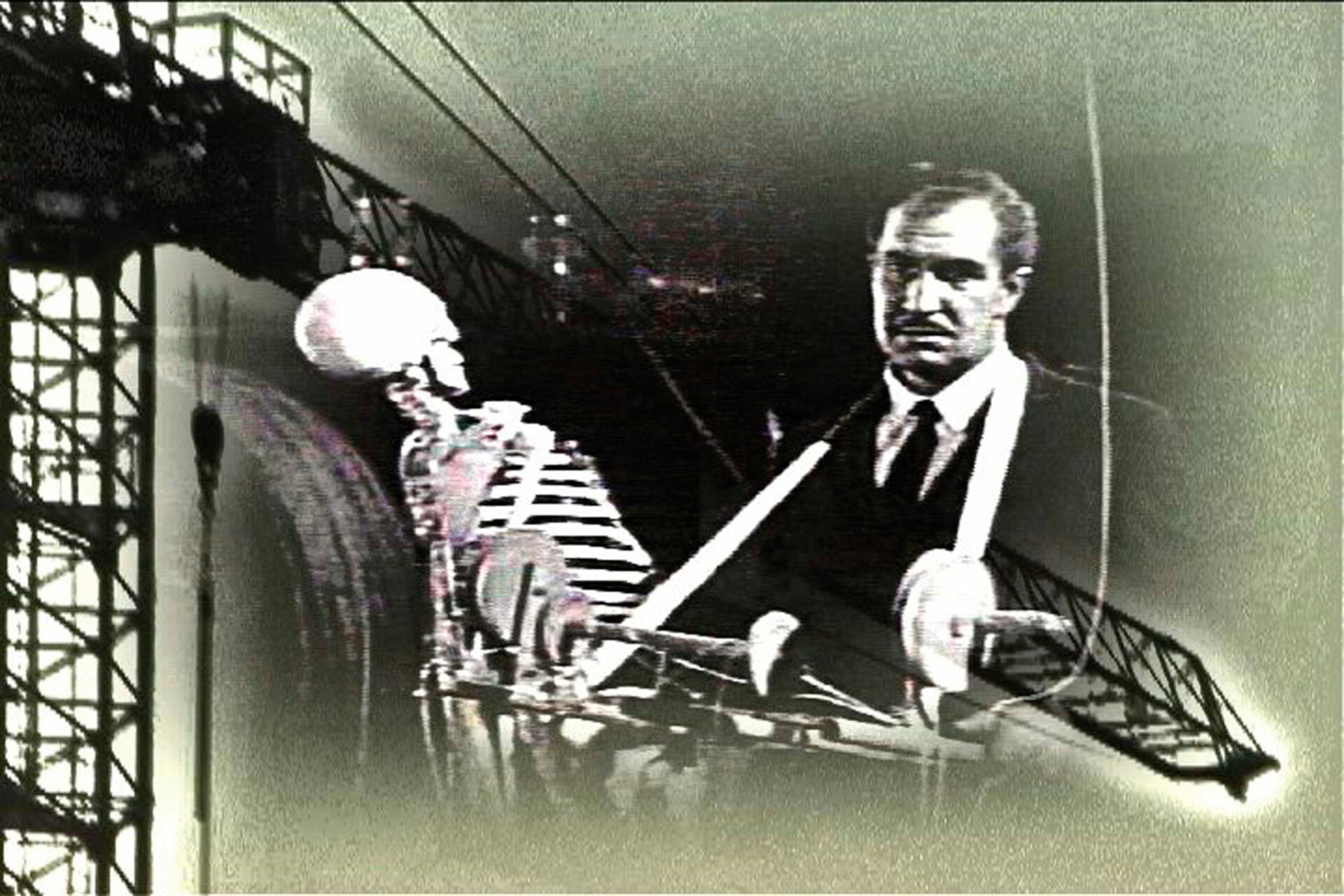
photo : permission de l'artiste | courtesy of the artist & Video Out Distribution
Easter Everywhere is a feature-length video/digital film by Vancouver artist Jeremy Todd, which debuted at Emily Carr University in 2008, screened at the Helen Pitt Gallery in the same year, and is currently distributed by Video Out. It overloads a 68-minute timeframe with fragments of plots, historical and futuristic epithets, and dense visual layering. A cable access TV show called Vancouver Rock Talk frames an investigation of the 1960s band the 13th Floor Elevators, while a blindfolded Lady Justice (played by the formidable Margaret Dragu) alludes to an apocalyptic future that unfurls in the aftermath of the 2010 Olympic Games. Pan shots move across rubble and layers of cranes at an Olympic construction site. A Man (played by Eric Metcalfe) sits in front of a camera surrounded by a microphone and candles, recording lonely ramblings. His image is intercut, incised and overwritten with fragments of films noirs: skulls, screaming damsels, severed heads. Readings from an unpublished novel by ex-Elevators’ drummer Danny Thomas, describing utopian dreams of pre-’68 psychedelia, recur throughout the work. The soundtrack feels like flipping through radio channels, cycling between the Elevators’ album Easter Everywhere and original music that is light, lonely, whimsical and contemplative.
I like to think of Easter Everywhere as a still life — one that is, ironically, stretched into the decidedly un-still mediums of video and music. Sill life with film noir, Justice, Rock Talk and Easter Everywhere: a movement-toward the (unimaginably) still, a teeming stilling, a memento mori for utopian yearnings. Emanating past and future tenses, the film speaks of before-the-revolution and after-the-apocalypse, bracketing out an indeterminate plane of enquiry: an unknowable surface-like present, a palimpsestic, endless cohabitation of plots and visuals which verges on their co-erasure. The narrative’s braided threads don’t add up to a clear structure but, rather, exist as a pile, a heap of possible constellations. Images are layered to the point where they verge on pure texture. This heaping structure enacts decay on the tissue samples of plots, characters, quotes, and images, inviting allegorical engagement with the work and its characters (as well as the “silent character” of the filmmaker, the one who has layered).


photos : permission de l’artiste | courtesy of the artist & Video Out Distribution
The characters (and particularly, the Man, whose plot-thread verges on a Beckett-like post-apocalyptic waiting game) emit a prosthetic field, which binds together portions of the layers. The Man is propped up on all sides by the overly symbolic images that surround and overwrite him — candles, microphones and shuffled papers, film-noir skulls. His lifelessness, narcissism and repetitiveness suck these objects in and he leans heavily on them, acting allegorically as a still-life object, enacting both the fluidity of the boundaries between subject and object and his reification as lonely, post-social being.
Easter Everywhere emits a field of ambivalence about utopian desires and their decay — a fondness for the quaint yearnings of generations past, and the quirks of those whose characters have been fashioned in relation to long-gone styles of hopefulness; a sincere wish to reconnect with now unfathomable social aims oscillating with the completely deflated hopelessness of being trapped within one’s own interpellations of capitalism as alienation-machine. (In a sense, this work locates the deathbed of the social within character: as the weightiness of individuals’ passive repetitions of reification that both constitute and colour the self-perception of subjectivity within capitalism.) It also, I believe, enacts ambivalence about its own efficacy as a medium and a methodology for opening up a politics of hope, for locating the possibility of finding another type of futurity. This ambivalence is akin to that of many seventeenth-century Dutch still-life paintings. Operating within the world’s first permanently affluent surplus society, in which individual households regulated surplus by accumulating luxuries, these paintings embodied the contradiction between, on the one hand, warning against an overinvestment in material wealth and, on the other, presenting themselves as sumptuous, indulgent objects of exchange.1 1 - For a discussion of this tension in Dutch still life, see Norman Bryson’s essay “Abundance,” Looking at the Overlooked: Four Essays on Still-Life Painting (London: Reaktion Books, 1990), 96-135, 115-21. With like ambivalence, Jeremy’s film, as it were, yearns for utopia by throwing it in the trash. However, as Norman Bryson points out, this sort of paradoxical construction is not necessarily a flaw; it can be a site of rich rhetorical complexity. It provokes an oscillation, calling into question the way a viewing subject — here hailed as a field of ambivalences and excesses — faces the complex relations between being and professing, seeing and understanding. In the face of this memento mori, this heaping pile of decayed textures-images-plots, one has, after a period of searching, the sensation that one can construct a comprehension very different from the appearance of the presented narratives. We can cleave, overwrite, infuse the allegory, pick out the sparks that sear between some of the images — these sparks that are the very stuff of creating and anticipating, without encoding, an unknowable futurity. The “future” the film literally depicts is a farce, a fear, a foil — a red herring clothing this other kind of facing-toward. The film wants us to recognize the resonance between its depicted dystopic future and futurity in itself, a potential which, here, lies in the space between the layers of an allegory.
